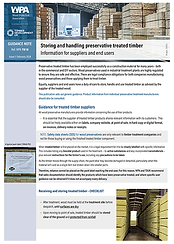tell me more
Wood preservatives used in industrial treatment plants are highly regulated to ensure they are safe and effective. Equally, suppliers and end users have a duty of care to store, handle and use treated timber as advised by the supplier of the treated wood product.

The following is a statement from the WPA regarding concerns over chemical burns from handling preservative treated roofing battens
19 January 2024
The Wood Protection Association (WPA) is aware of an industry news item that appeared on 16th January 2024 in ‘Roofing Today’ that included claims that preservative treated roofing battens were responsible for causing chemical skin burns and health risks. It is reported that thousands of cases have surfaced. The wood preservation industry takes such allegations very seriously and the health and safety of those using wood preservatives or treated wood is the number one priority for the industry.
Wood preservatives for use in industrial treatment plants are highly regulated to ensure they can be used safely. There are legal compliance obligations that must be adhered to by companies manufacturing wood preservatives and those using them to treat wood. Equally, end users have a duty of care to store, handle and use treated wood as prescribed by the manufacturer of the preservative used and suppliers of treated wood.
Prior to placing on the market, manufacturers must carry out a comprehensive suite of independent tests the results of which are scrutinised by authorising bodies, such as the UK HSE, before authorisation for use is granted. These include safety and environmental studies which involves extensive testing. Only when that work is completed can authorisation be granted. Since Brexit, supply and use of preservatives are governed by the Biocidal Products (Health and Safety) (Amendment) Regulations 2022 that implement an amended version of the EU Biocidal Products Regulation (BPR).
The news item stated that permethrin had been identified as being at the core of the issue. Permethrin is a widely used insecticide that is approved for use for numerous applications including pet flea treatment, skin treatment for scabies and wood preservatives.
It is important that all biocidal products, including wood preservatives, are authorised for use and used as directed on the label. When handling treated wood, precautions are generally the same as untreated wood and include wearing gloves plus a dust mask and goggles if machining and creating dust. Suppliers of treated wood will be able to provide product specific handling information and instructions and this is provided on the pack label.
Safety data sheets for the wood preservative itself do not provide appropriate information for handling preservative treated wood. Therefore, they cannot be used when carrying out a COSHH risk assessment for treated wood but a user guide will be available for this purpose.
The WPA recommends that users of treated wood only buy wood that has been treated with a preservative authorised for use in the UK by the Health and Safety Executive (HSE) or containing active substances listed in the HSE BPR active substance lists for GB or N Ireland. Do not buy any material of dubious origin not knowing what it has been treated with.
The WPA intends to investigate these concerns whilst at the same time continue to promote the use of regulated, safe and effective wood preservatives.
Timber Development UK (TDUK) has a campaign to urge its members and their clients to always purchase good quality battens that comply with British Standards BS 5534 and BS 8417, preferably third party quality assured ‘TDUK Trade Note ‘Tile Batten Quality Control’.


